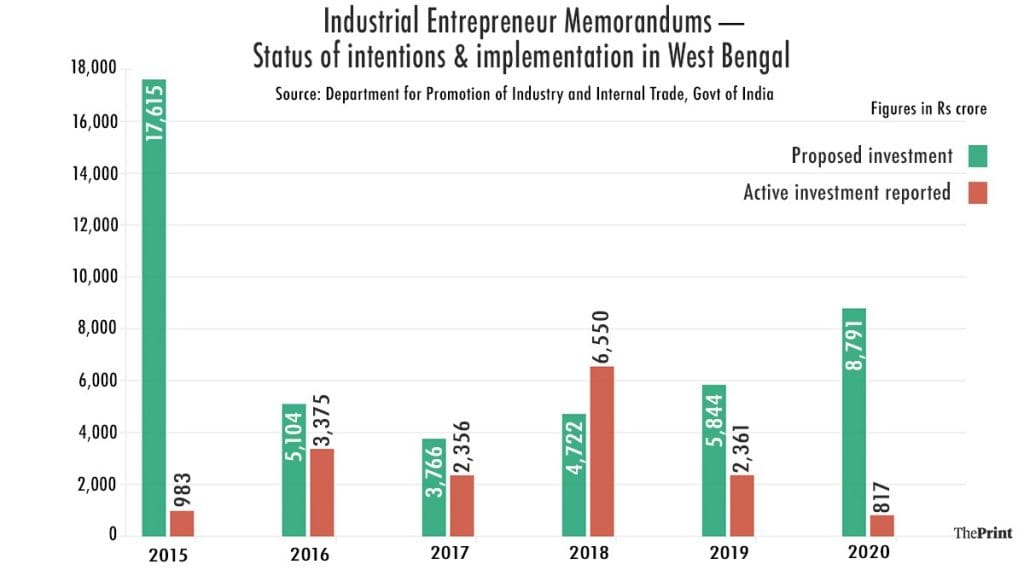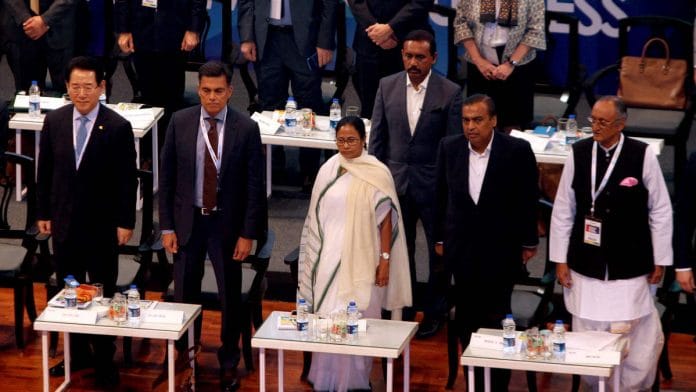Kolkata: Mamata Banerjee’s Trinamool Congress government in West Bengal has often highlighted the amount of investment it has been able to attract as one of its achievements.
Just last year, in response to questions from Governor Jagdeep Dhankhar about Bengal Global Business Summit (BGBS), Finance and Industries Minister Amit Mitra said over five editions of the event between 2015 and 2019, it had received over Rs 12.32 lakh crore worth of investment proposals, of which over 50 per cent (worth Rs 6.2 lakh crore) had gone into ‘implementation mode’.
However, documents accessed by ThePrint show that there are huge discrepancies between the Bengal government’s claims and records maintained by the Department of Promotion of Industry and Internal Trade (DPIIT), a nodal agency under the Union Ministry of Commerce and Industry.
The DPIIT documents show that between 2015 and 2019, Bengal has received investment proposals worth Rs 37,051 crore, of which projects worth Rs 15,625 crore, or 2.5 per cent of the amount claimed by the state government, have been implemented.
ThePrint spoke to multiple central and state government officials about these vastly different amounts, and while state industry department officials said discrepancies might have occurred because DPIIT uses a different set of data, the central department’s officials insisted it only records final investment proposals or written applications accepted by state governments.
Industry experts say this is not the first time a state’s investment numbers have been “inflated”, adding that ruling parties — not just the Trinamool Congress — tend to do so for political gains.
Trinamool leaders have accused the BJP-led Narendra Modi government of “fudging” data to “create confusion” and “demean opponents”, while the BJP and the Left Front have made the “inflated data” a stick to beat the ruling party with ahead of the assembly elections expected in April-May.
Also read: ‘Will suffer Mamata misrule, not BJP’ — Bengal intellectuals don’t want another ‘poriborton’
What the data shows
In his budget speech in February 2020, Bengal Finance Minister Amit Mitra had said the fifth edition of the BGBS in February 2019 had attracted investments worth Rs 2,84,288 crore.
Governor Dhankhar then sent two letters in August 2020 — one to Mitra on 8 August and the other to CM Mamata Banerjee on 25 August — seeking details of investment proposals received through the BGBS and the status of their implementation.
Mitra responded to Dhankhar in a letter dated 24 September, saying: “The cumulative investment proposals received in BGBS 2015 through BGBS 2019 amounted to Rs 12,32,603 crore.”
He added that proposals worth 50.27 per cent of this amount are in several stages of implementation. “For BGBS 2019, already Rs 71,646 crore is under implementation,” the minister said.
However, state-wise data published by DPIIT shows that Bengal received investment proposals worth Rs 5,844 crore in 2019, and projects worth Rs 2,361 crore were initiated.
Asked about this discrepancy, a top official of the West Bengal Industrial Development Corporation (WBIDC) said: “Discrepancies occur as agencies use different sets of data. We send all official data to the ministry. We will look into the discrepancies.”
However, the state’s own economic review for 2017-18, available on the website of the Department of Planning & Statistics, quotes DPIIT data on Industrial Entrepreneur Memorandums (IEMs).

ThePrint emailed and texted a detailed questionnaire to Amit Mitra and Vandana Yadav, secretary of industry and commerce and managing director of the WBIDC, seeking clarification on the discrepancies, but didn’t receive a response till the time of publishing this report.
Abhirup Sarkar, senior economist at the Indian Statistical Institute and vice-chairman of WBIDC, said the governments collate data based on the applications received. But, asked about the discrepancies, he said: “I am not aware of the state and central statistics.”
Announced numbers have little credibility, experts say
Industry and economy experts say ruling parties tend to “inflate investment data” for political gain.
Anup Sinha, economist and former professor at IIM Calcutta, said: “Several data are presented at different levels. There is no break-up available. Politicians generally tend to inflate data. For such discrepancies, the state government should bring in a white paper and clear up such confusion.”
Suparno Moitra, economist and former regional director of IT and business process management trade body Nasscom in the eastern region, said: “The gap between the IEMs signed and implemented have always been huge for any state. Industry leaders announce investment at the drop of a hat. But, as far as the implemented projects are concerned, as a country, we have failed to get more attention to manufacturing.”
Rajesh Chakrabarti, Dean of the Jindal Global Business School, said: “State-level business summits started with Vibrant Gujarat. All other states followed. It is a healthy thing, and we get to hear fantastic figures. But for most states, the announcements appear to have very little credibility.”
He added: “Most of these announcements turn out to be marketing gimmicks with no real ground-check. But the discrepancies between state and centre figures on implementation are something interesting, that should not have happened. Exaggeration of numbers can be explained, but why are there discrepancies in implemented projects? Even if there is some delay in recording figures, it cannot be such a minuscule percentage of what the state claims.”
Also read: Mega shows like Narendra Modi’s pet ‘Vibrant Gujarat’ do not bring investments or jobs
Political slanging match
The discrepancies in data have started another political slanging match in poll-bound Bengal.
CPI(M) leader Asim Dasgupta, former finance minister of Bengal, hinted that data inflation was a practice followed by the Trinamool Congress, but not the previous Left Front governments in the state.
“During the Left Front government’s tenure, we used to send the data after receiving the written applications from the investors. We never announced or committed any figures that were mentioned verbally. DPIIT only records what they get from the state. That is the standard protocol,” Dasgupta said.
Trinamool Congress leaders, meanwhile, claimed the Modi government routinely “fudges” all data.
“The BJP only wants to create confusion among people. The Modi government is infamous for fudging data. His economic advisors also spoke out against him. It was reflected in the Economic Survey too. They may have fudged all data to demean their political opponents,” said Trinamool MP Sougata Roy.
BJP leaders retorted by saying the central government does not recognise “verbal announcements”, only “documented facts”.
“I would have been happy if the figures announced by Dr Mitra came any close to reality. Unfortunately, it seems that the figures were announced only for the sake of announcements,” said Sisir Bajoria, an industrialist, former director of WBIDC and member of the BJP’s state executive committee.
“If an industry comes, it will come on the ground and people will see the chief minister inaugurating it. Where are the factories? Has anyone seen the chief minister inaugurating any such project?” Bajoria asked.
“Figures announced in business summits find no place in DPIIT data. Only the figures mentioned in the applications accepted and approved by the state are recorded there,” he added.
Bengal as an investment destination
On how Bengal is shaping up as an investment location in reality, Prof. Chakrabarti said: “There are possibilities and good intent, but everything gets diluted at the ground level. Bengal has been suffering from work culture and union issues for decades, starting with the Left rule. I keep getting conflicting reports on Bengal as an investment location.”
Sandip Ghose, corporate strategy adviser and business leader, said: “Statistics only reveal what is indicative. Certainly, some investment has come in, but the potential and the requirement is huge. West Bengal has a lot of catching up to do compared to other developed states.”
Ghose added: “For Bengal to become an attractive destination — the work culture will have to change and local political interference has to be checked and controlled by the district administration and government.”
Also read: Why Bengal can vote for BJP, even though Mamata Banerjee is still invincible







No one fudges data better than the communists. No one rigs elections so successfully as our beloved comrades. They may indulge in a blame game with the BJP and the TMC but the fact remains that they are the original masters of propaganda. The Nazi propaganda machinery seems amateurish in comparison.